Pineapple guava, Feijoa
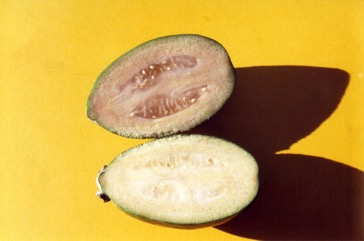
It is a warm temperate and subtropical plant. It suits cool places and can tolerate temperatures below freezing when the plant is in its dormant stage. It needs good drainage but can grow on fairly poor soils. Feijoas prefer cool winters and moderate summers (26° to 32°C), and are generally adapted to areas where temperatures stay above -9°C. They need 50 hours of chilling for good flower production. Fruit taste better in cooler than warmer climate. Plants can tolerate seaside locations. It does best in warm and subtropical zones. They are not well suited to tropical regions. It suits hardiness zones 8-11. In Melbourne Botanical Gardens. In Hobart Botanical gardens. In Brisbane Botanical Gardens.
Also known as:
Ananasova gvava, Goiaba-do-campo, Goiaba serrana, Goiaba verde, Goiabo abacaxi, Goiabeira-serrana, Guayaba chilena, Guayabo chico, Guayabo grande, Jambu nanas
Synonyms
- Feijoa sellowiana (O. Berg) O. Berg.
- Orthostemon sellowianus O. Berg.
- Orthostemon obovatus O. Berg.
- Feijoa obovata (O. Berg.) O. Berg.
- Feijoa schenkiana Kiaersk.
Edible Portion
- Fruit, Flowers, Vegetable
Where does Pineapple guava grow?
Found in: Africa, Argentina, Asia, Australia, Azerbaijan, Bahamas, Brazil, Britain, Caucasus, Central America, Chile, China, Cook Islands, Costa Rica, Cuba, East Africa, Europe, France, Georgia, Hawaii, Himalayas, India, Indochina, Indonesia, Israel, Italy, Jamaica, Kenya, Madagascar, Mexico, New Zealand, North America, Pacific, Papua New Guinea, PNG, Paraguay, Philippines, Portugal, Russia, SE Asia, Slovenia, South America, Spain, Switzerland, Tasmania, Uruguay, United States
Notes: There are 6 Acca species. The fruit of this one has high levels of water soluble iodine. (1.6-4 mg/kg) They are also rich in folic acid. Fruit are high in folates 91μg/100.
Status: It is a significant fruit tree. Trees have been tried in a few highland areas in Papua New Guinea but so far have not established or produced well. Cultivated.
Growing Pineapple guava, Feijoa
Cultivation: Trees can be grown from seed and transplanted. Seedling trees are not always true to type. Seed is extracted by squeezing fruit into water and letting it ferment for 4 days. Seeds are then strained out and dried. Seed can be stored dry for 12 months. Seeds germinate in 3 weeks. Grafting or cuttings can also be used with some difficulty. Young wood cuttings will root in 2 months with bottom heat and mist. Layering can also be used. Some kinds need to have cross pollination to produce fruit. It does not need any special pruning, although lateral branches can be removed to avoid overcrowding. A spacing of 2 metres is recommended.
Edible Uses: The fruit are used raw or cooked. They can be used for jellies and sauces. The flower petals can be eaten raw.
Production: Plants grow slowly. Trees start to fruit after 3-4 years. Fruit needs to be stored for a week or more after it falls from the tree, to become fully ripe. Birds and bees pollinate the flowers. Poor fruit bearing is normally the result of poor pollination. Fruit ripen in 4-7 months. Mature fruit can be stored in a refrigerator for about one week. Fruit can be stored at 3-5°C for 2-3 months. Dipping fruit in lemon juice after peeling stops the fruit turning brown.
Nutrition Info
per 100g edible portion| Edible Part | Energy (kcal) | Protein (g) | Iron (mg) | Vitamin A (ug) | Vitamin c (mg) | Zinc (mg) | % Water |
|---|---|---|---|---|---|---|---|
| Fruit | 49 | 1.2 | 0.1 | 0 | 20 | 0.04 | 86.6 |
| Flowers | - | - | - | - | - | - |
Pineapple guava, Feijoa Photos

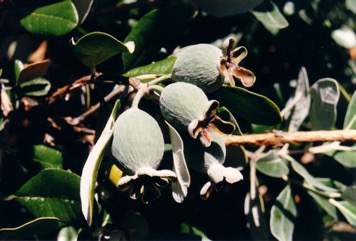
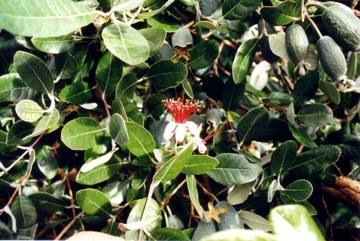
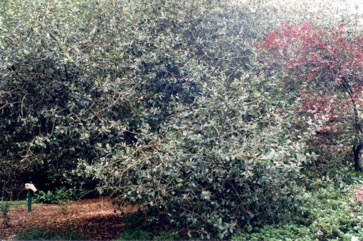
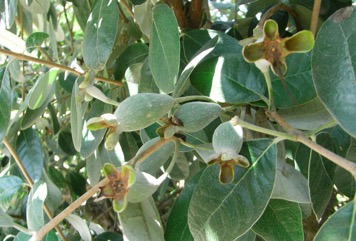
References
Ambasta, S.P. (Ed.), 2000, The Useful Plants of India. CSIR India. p 219 (As Feijoa sellowiana)
Arora, R. K., 2014, Diversity in Underutilized Plant Species - An Asia-Pacific Perspective. Bioversity International. p 70 (As Feijoa sellowiana)
Bodkin, F., 1991, Encyclopedia Botanica. Cornstalk publishing, p 470
Brazil: Biodiversity for Food and Nutrition. http://www.b4fn.org/countries/brazil/
Brickell, C. (Ed.), 1999, The Royal Horticultural Society A-Z Encyclopedia of Garden Plants. Convent Garden Books. p 63
Burkill, I.H., 1966, A Dictionary of the Economic Products of the Malay Peninsula. Ministry of Agriculture and Cooperatives, Kuala Lumpur, Malaysia. Vol 1 (A-H) p 1014 (As Feijoa sellowiana)
Cheifetz, A., (ed), 1999, 500 popular vegetables, herbs, fruits and nuts for Australian Gardeners. Random House p 191
Coronel, R.E., 1982, Fruit Collections in the Philippines. IBPGR Newsletter p 9 (As Feijoa sellowiana)
Cundall, P., (ed.), 2004, Gardening Australia: flora: the gardener's bible. ABC Books. p 82
Etherington, K., & Imwold, D., (Eds), 2001, Botanica's Trees & Shrubs. The illustrated A-Z of over 8500 trees and shrubs. Random House, Australia. p 58
Facciola, S., 1998, Cornucopia 2: a Source Book of Edible Plants. Kampong Publications, p 157 (As Feijoa sellowiana)
Flowerdew, B., 2000, Complete Fruit Book. Kyle Cathie Ltd., London. p 154
Fouqué, A., 1972, Espèces fruitières d'Amérique tropicale. Institut français de recherches fruitierès outre-mer (ifac)
French, B.R., 1986, Food Plants of Papua New Guinea, A Compendium. Asia Pacific Science Foundation p 296
Gouldstone, S., 1983, Growing your own Food-bearing Plants in Australia. Macmillan p 96 (As Feijoa sellowiana)
Grandtner, M. M. & Chevrette, J.,2013, Dictionary of Trees, Volume 2: South America: Nomenclature, Taxonomy and Ecology. Academic Press p 9
Hackett, C. & J. Carolane. 1982. Edible Horticultural Crops.
Hermandez Bermejo, J.E., and Leon, J. (Eds.), 1994, Neglected Crops. 1492 from a different perspective. FAO Plant Production and Protection Series No 26. FAO, Rome. p16, 233
Hu, Shiu-ying, 2005, Food Plants of China. The Chinese University Press. p 577 (As Feijoa sellowiana)
Hunter, D., et al, 2019, The potential of neglected and underutilized species for improving diets and nutrition. Planta (2019) 250:709-729
Jardin, C., 1970, List of Foods Used In Africa, FAO Nutrition Information Document Series No 2.p 118
John, L., & Stevenson, V., 1979, The Complete Book of Fruit. Angus & Robertson p 131
Kinupp, V. F., 2007, Plantas alimenticias nao-convencionais da regiao metropolitana de Porto Alegre, RS, Brazil p 84
Kinupp, V. F. & Bergman, I., 2008, Protein and minerals of native species, potential vegetables and fruits. Cienc.Tecnol. Aliment. Vol. 28 No. 4 Campinas Oct/Dec.
Kiple, K.F. & Ornelas, K.C., (eds), 2000, The Cambridge World History of Food. CUP p 1772 (As Feijoa sellowiana)
Kunkel, G. Plants for human consumption
Llamas, K.A., 2003, Tropical Flowering Plants. Timber Press. p 282
Morton, Julia F., 1987, Fruits of Warm Climates. Creative Resources Systems, Inc. . p. 367 (As Feijoa sellowiana)
Lorenzi, H., 2002, Brazilian Trees. A Guide to the Identification and Cultivation of Brazilian Native Trees. Vol. 01 Nova Odessa, SP, Instituto Plantarum p 270
Lorenzi, H., Bacher, L., Lacerda, M. & Sartori, S., 2006, Brazilian Fruits & Cultivated Exotics. Sao Paulo, Instituto Plantarum de Estuados da Flora Ltda. p 176
Lyle, S., 2006, Discovering fruit and nuts. Land Links. p 202
Macmillan, H.F. (Revised Barlow, H.S., et al) 1991, Tropical Planting and Gardening. Sixth edition. Malayan Nature Society. Kuala Lumpur. p 314
Martin, F. W., et al, 1987, Perennial Edible Fruits of the Tropics. USDA Handbook 642 p 41
Martin, F.W., C.W. Campbell and R.M. Ruberté, 1987, Perennial edible fruits of the tropics - An inventory. United States Department of Agriculture, Agricultural Research Service, Agriculture Handbook No. 642. Washington, D.C., USA.
Mabberley, D. J., 1990, The plant-book: a portable dictionary of the higher plants. Cambridge University Press. NY.
Miguel, E., et al, 1989, A checklist of the cultivated plants of Cuba. Kulturpflanze 37. 1989, 211-357
Morley, B. & Everard, B., 1970, Wild Flowers of the World. Ebury press. Plate 179
Permaculture website Ngare Ndare project Kenya
Perry, F., and Hay, R., 1982, Guide to Tropical and Subtropical Plants. Sun Books p 30
Plants for a Future database, The Field, Penpol, Lostwithiel, Cornwall, PL22 0NG, UK. http://www.scs.leeds.ac.uk/pfaf/
Purseglove, J.W., 1968, Tropical Crops Dicotyledons, Longmans. p 398
Recher, P, 2001, Fruit Spirit Botanical Gardens Plant Index. www.nrg.com.au/~recher/ seedlist.html p 2 (As Acca sellowiana)
Repert. Spec. Nov. Regni Veg. 50:59. 1941
Segura, S., et al, 2018, The edible fruit species in Mexico. Genet Resour Crop Evol (2018) 65:1767–1793
Self, M., 199, Phoenix Seeds catalogue. p 15
Solomon, C., 2001, Encyclopedia of Asian Food. New Holland. p 142
Staples, G.W. and Herbst, D.R., 2005, A tropical Garden Flora. Bishop Museum Press, Honolulu, Hawaii. p 417
Striegel, L., et al, 2019, Promising Tropical Fruits High in Folates. Foods 2019, 8, 363; doi:10.3390/foods8090363. www.mdpi.com/journal/foods
Sukarya, D. G., (Ed.) 2013, 3,500 Plant Species of the Botanic Gardens of Indonesia. LIPI p 578
Tankard, G., 1990, Tropical fruit. An Australian Guide to Growing and using exotic fruit. Viking p 42
USDA, ARS, National Genetic Resources Program. Germplasm Resources Information Network - (GRIN). [Online Database] National Germplasm Resources Laboratory, Beltsville, Maryland. Available: www.ars-grin.gov/cgi-bin/npgs/html/econ.pl (10 April 2000)
van Wyk, B., 2005, Food Plants of the World. An illustrated guide. Timber press. p 40
World Checklist of Useful Plant Species 2020. Royal Botanic Gardens, Kew
www.worldagroforestrycentre.org/treedb/ (As Feijoa)